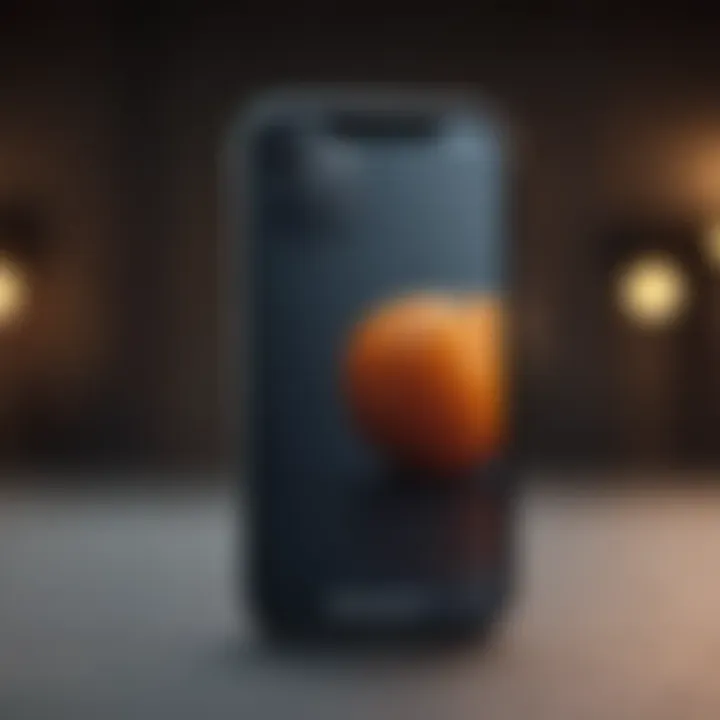Understanding the Pricing of the iPhone 12: A Comprehensive Guide


Intro
The pricing of the iPhone 12 holds significance for many consumers. As one of the most well-known smartphones by Apple, understanding its price structure is vital in making informed purchasing decisions. It is not just about the base price, but also about variations in storage options, geographical influences, and market conditions. This guide explores those factors and provides a clear analysis of what influences the pricing of the iPhone 12.
Overview of Pricing Factors
Definition
The pricing of the iPhone 12 refers to the various costs associated with acquiring the device, including the base price, the impact of additional features, and any potential discounts or promotions.
Key Features
The iPhone 12 is available in different storage capacities: 64GB, 128GB, and 256GB. This variation affects the initial price.
Purpose and Benefits
Understanding these pricing factors helps consumers evaluate their options and make strategic choices based on their personal or family needs.
Market Variations
Geographical Influences
Prices for the iPhone 12 can differ substantially based on location. Factors like local taxes, import duties, and currency exchange rates can all play a role. For instance, the cost in the United States can be different from prices in Europe or Asia.
Storage Considerations
The choice of storage option drastically modifies pricing. Higher storage variants tend to be significantly more expensive, appealing to users with heavy app needs or those who utilize the camera frequently.
Comparison to Previous Models
When assessing the pricing of the iPhone 12, it is helpful to compare it to earlier iPhone models. The introduction of the iPhone 12 also meant price adjustments for older models, making them more attractive in the market.
Promotions and Discounts
Apple occasionally runs promotions which can influence the effective price customers pay. Seasonal sales, trade-in programs, and carrier-sponsored deals may help consumers save money if they purchase the iPhone 12 during specific time frames.
Resale Value Considerations
The resale market for iPhones is robust. Resale values can heavily influence the perceived cost of owning an iPhone 12. Understanding how depreciation works as part of ownership can aid in decision-making.
Demographics and Purchasing Context
Buying Behavior Trends
Demographics, such as age and income level, can significantly impact purchasing behavior and price sensitivity. Young professionals might prioritize the latest technology while families may look for the best value or durability in their iPhone selection.
Prelims to iPhone Pricing
Understanding the pricing of the iPhone 12 is crucial for both potential buyers and tech enthusiasts. As one of Apple's prominent devices, the pricing structure reflects various elements that shape its market presence. This section aims to clarify why discerning the costs associated with the iPhone 12 can influence purchasing decisions. It offers insight into how factors such as storage options, market dynamics, and promotional offers can affect the final price.
Overview of iPhone Features
The iPhone 12 comes with significant features that distinguish it from its predecessors. With its A14 Bionic chip, superior camera system, and 5G capabilities, the iPhone 12 represents a flat form of innovation. The design includes a ceramic shield front, which provides up to four times better drop performance. The device has OLED display, offering better contrast and vibrant colors, distinguishing it in the smartphone market. These features create a strong value proposition, but they also contribute to its pricing strategy.
Significance of Understanding Pricing
Understanding the pricing of the iPhone 12 is essential for consumers, as it is not just about the initial purchase price but also about long-term investment. Knowing the retail price helps consumers recognize a good deal when they see it. Moreover, familiarizing oneself with the various storage options can lead to smarter choices that align with individual needs.


It’s important to consider that prices may vary significantly depending on several factors. For example, promotions can cause temporary dips in standard prices, while geographic pricing variations can lead to inconsistencies in cost depending on the region. Therefore, being informed about these elements can help individuals to make better investment decisions.
Base Model Pricing
Base model pricing serves as a crucial anchor point in understanding the overall cost structure of the iPhone 12. By examining the base model, consumers can make informed decisions based on the fundamental features each model offers without modifications or upgrades. This understanding is essential as it lays the groundwork for evaluating which specifications are necessary, helping potential buyers navigate their choices.
Standard Model Cost
The standard model of the iPhone 12 was launched at a price point that corresponds with its feature set and target demographic. Typically, the launch price for the base iPhone 12 model was approximately $699. This price reflects a combination of factors, including innovative technological enhancements, brand positioning, and Apple’s reputation for quality.
The pricing may also be interpreted in light of competitive offerings from other manufacturers in the smartphone market. For young professionals and families, this base price can represent a significant commitment, thus warranting a careful assessment of whether the investment aligns with their needs and desires.
It’s noteworthy that prices fluctuate over time due to technological advancements and market competition. Consumers should closely monitor any changes in pricing that may occur shortly after launch or during promotional periods.
Storage Options and Their Prices
The iPhone 12 comes in several storage options: 64GB, 128GB, and 256GB. Each of these variants commands a different price. The baseline of 64GB allows for essential app usage and casual photo storage, whereas the 128GB option is more comfortable for users engaging in extensive media capture or gaming. The 256GB variant caters to individuals who prioritize multimedia experience and extensive storage for apps and files.
- 64GB Model: Starting at $699
- 128GB Model: Starting at around $749
- 256GB Model: Starting at about $849
This pricing strategy highlights how storage needs significantly influence final decisions. Buyers should evaluate their usage patterns, as opting for a higher storage variant could prevent future issues like running out of space. Understanding these distinctions aids consumers in selecting the model that best fits their lifestyle and usage habits.
Investing in an iPhone 12 is not simply about purchasing a phone; it's about choosing the right specifications that resonate with one's personal and professional life.
Market Pricing Dynamics
Pricing dynamics in the mobile phone market, particularly for a product like the iPhone 12, are critical to understand. These dynamics are shaped by various factors including supply and demand, competition, and consumer preferences. Exploring these elements can help potential buyers make informed decisions, clarifying how market conditions influence the price of the iPhone 12.
Impact of Supply and Demand
Supply and demand are fundamental principles driving the economy. In the case of the iPhone 12, supply refers to the availability of the device in the market. If Apple releases widely enough to meet market expectations, prices are likely to stabilize. However, if demand exceeds supply, we observe price jumps.
- Limited availability right after launch often leads to higher prices. Limited stock encourages a sense of urgency amongst consumers.
- Conversely, when supply increases, perhaps due to new production techniques or reduced demand, prices may drop, offering consumers better deals.
Factors influencing consumer demand for iPhone 12 include brand loyalty, features, and marketing campaigns. For instance, if Apple emphasizes new features, potential customers might be more inclined to purchase. This interplay creates an ongoing balancing act between supply and demand that impacts pricing.
Comparative Pricing Analysis with Older Models
Examining the pricing of the iPhone 12 in comparison to older models sheds light on its market positioning. The iPhone 12 introduced several improvements over its predecessors, including enhanced processing power, improved camera technology, and support for 5G. Consequently, the pricing strategy adopted reflects these advancements.
- iPhone 11 vs. iPhone 12: While the iPhone 11 maintained a lower price, the iPhone 12’s upgrades justified its higher cost. Potential buyers often evaluate value for money when choosing between these models.
- Price Trends: As new models are released, older models typically see a reduction in price. This is an essential consideration for consumers looking for better value without needing the latest features.
Delving into these aspects can assist young professionals and families in finding the right purchase. Choosing between the iPhone 12 and older models is about aligning individual needs with budgetary constraints and desired features.
Key Point: Understanding pricing dynamics through supply and demand and comparative pricing analysis is vital for making informed buying decisions in the tech market.
Factors Influencing iPhone Prices
Understanding the factors that drive iPhone 12 pricing is crucial for consumers. This knowledge helps in making an informed purchase decision and identifying the best value for money. Several elements contribute to the overall cost of the iPhone 12, including retailer promotions, geographic pricing variations, and market dynamics. In this section, we will examine these components in detail.
Retailer Promotions and Discounts
Retailers often run specific promotions that can significantly influence the price of the iPhone 12. These sales can take various forms, including discounts, trade-in offers, and bundles with accessories. For example, during holidays or shopping events like Black Friday, incentives can save consumers a notable amount. Here are some common types of retailer promotions:
- Limited-Time Discounts: Retailers may offer temporary price cuts that make the iPhone 12 more attractive. This practice can lead to price fluctuations and consumers feeling urgency to purchase.
- Trade-In Offers: Many retailers provide credit towards a new iPhone 12 when consumers trade in their old devices. This can significantly reduce the effective cost.
- Bundled Offers: Some retailers pair the iPhone 12 with accessories such as cases, chargers, or headphones at a reduced price. Consumers may perceive increased value in these bundles.
It is important for buyers to be aware of these promotions as they can lead to optimal purchasing opportunities. Research and comparison shopping are advisable to maximize savings.


Geographic Pricing Variations
The location of a consumer can affect the pricing of the iPhone 12. Geographic pricing variations occur due to factors such as economic conditions, taxes, and local market demand. Different regions often have different retail prices, making it essential to be aware of these differences when considering a purchase. Here are some points to consider:
- Tax Implications: Sales tax rates vary by state or region, leading to price differences. Purchasers in one area may pay significantly more than those in a different jurisdiction.
- Exchange Rates: For international buyers, currency fluctuations can also affect pricing. The iPhone 12's price may differ based on the local currency's strength compared to the U.S. dollar.
- Market Demand: In regions where the demand is high, prices for new technology can rise. Conversely, areas with less demand may see more competitive pricing.
Understanding these geographic pricing variations allows consumers to make better purchasing decisions. It may be beneficial to look broader than local options, as potential savings can be found in other locations.
Evaluating both retailer promotions and geographic pricing can significantly affect the total cost of acquiring an iPhone 12 and impacts the overall value for consumers.
Resale Market Considerations
Understanding the resale market for the iPhone 12 is crucial for both buyers and sellers. It provides insights not only into price trends but also into consumer preferences and technology longevity. The resale value of a device can directly impact the total cost of ownership. Knowing these market dynamics can help inform purchasing decisions.
Depreciation Rate of iPhone
The depreciation rate of the iPhone 12 is a significant factor when considering its resale value. Typically, smartphones depreciate rapidly within the first year after release. iPhones, however, have a somewhat slower depreciation rate compared to many Android devices. On average, within the first year, an iPhone can lose 20-30% of its initial value.
Various factors can influence this depreciation. Elements such as storage capacity and condition have a notable impact. Simply put, higher storage options might retain their value longer. Moreover, limited edition colors or configurations can also fare better in the resale market.
For people looking to recoup costs, it's beneficial to keep the device in good condition. Accessories, such as cases and screen protectors, can protect against wear and damage, enhancing resale appeal.
"Understanding how much value a smartphone can lose over time can help in planning for future purchases."
Condition and its Impact on Resale Value
The condition of the iPhone 12 significantly affects its resale value. A device in pristine condition typically commands a higher price. Factors that determine condition include physical appearance, functionality, and overall wear.
Many buyers prefer a device that appears new. Scratches, dents, or cracks can drastically lower the price. A well-maintained phone with original packaging and accessories may attract collectors or resale enthusiasts.
Several key conditions to consider:
- Physical Condition: Look for signs of wear on the screen and body.
- Battery Health: A battery that is degraded will decrease desirability.
- Functional Integrity: Ensure all features, such as cameras and buttons, operate correctly.
Maintaining good condition not only benefits the resale process but also contributes to the overall lifespan of the device. For those planning to sell, taking proactive steps to keep the iPhone 12 in excellent condition can lead to a more favorable market experience.
Consumer Behaviors and Preferences
Understanding consumer behaviors and preferences is crucial in analyzing the pricing of the iPhone 12. This examination provides insight into how different demographics approach purchasing decisions. As we recognize those diverse patterns, we can discern trends that influence prices and the market.
Young Professionals' Buying Patterns
Young professionals represent a significant segment of the iPhone 12's consumer base. Their buying decisions often stem from a blend of practicality and desire for the latest technology. They tend to prioritize features that enhance productivity, such as high processing power and camera quality. According to recent studies, young buyers are influenced by brand reputation and the status associated with owning an iPhone.
Many young professionals lean towards financing options if they find initial costs prohibitive. They appreciate flexible payment plans from carriers, allowing them to manage expenses conveniently. In addition, they often seek devices that integrate seamlessly with productivity tools, reinforcing their commitment to value over mere aesthetics.
Studies show that technology purchases among young professionals are often tied to work-related needs and lifestyle enhancement.
Family Considerations in Technology Purchases
Families approach technology purchases, including the iPhone 12, with deliberation. Price is a key factor, as parents assess total costs that affect household budgets. Furthermore, families may focus on the device's ability to cater to various needs, from education and communication to entertainment.
Families typically evaluate durability and usability for children alongside pricing. Features like parental controls and educational apps gain importance. Parents are often inclined to invest in a device perceived as reliable and long-lasting, particularly when finances are tight. Importantly, family plans offered by carriers can also influence decisions, providing a more economical pathway to acquire multiple devices.
In summary, both young professionals and families exhibit distinct patterns in their purchasing behaviors that directly impact how pricing models for the iPhone 12 are structured. Recognizing these behaviors equips potential buyers with valuable insights when considering their next purchase.
Comparison with Competing Products


Understanding how the iPhone 12 stacks up against competing products is crucial for potential buyers. This section examines both pricing and features, presenting an informed perspective that aids consumers in making educated choices. With so many smartphones available, discerning which model offers the best value becomes a pivotal aspect of the purchasing process.
Pricing Against Other Smartphones
In the smartphone market, the pricing of devices can vary greatly. When comparing the iPhone 12 to similar products, several key aspects emerge.
- Base Price: The iPhone 12 starts with a specific base price, which must be matched against competitors like Samsung Galaxy S21 and Google Pixel 5. These brands typically offer their flagship models at a comparable price point but often with different promotional offers.
- Storage Considerations: Storage options can also impact the overall pricing. While the iPhone 12 starts at one price for the base model, other options can increase that cost significantly. Competitors may offer a more generous storage capacity at the same entry price.
- Ecosystem Influence: The influence of the Apple ecosystem might justify a higher price for some consumers. They are investing not just in a phone, but an entire interconnected system of products and services.
“Understanding the context of pricing helps consumers see the bigger financial picture.”
Feature-to-Price Ratio of the iPhone
The features embedded in the iPhone 12 must also be taken into account when assessing its price. This analysis can provide a clearer picture of what the consumer receives for the amount spent.
- Camera Technology: The iPhone 12 houses advanced camera technology, including Night Mode and Deep Fusion, which may surpass the quality of similar models. Such features could justify the price tag, especially for photography enthusiasts.
- Display Quality: The Super Retina XDR display offers top-tier visual resolution and brightness. This feature can outshine competitors that offer lower-quality screens for a similar price.
- Software Updates: Apple is known for its long-term software support. With the iPhone 12, users can expect updates for several years. That longevity enhances the device's price-to-value ratio compared to models from manufacturers who may not provide consistent updates.
In summary, comparing the iPhone 12 with competing products involves assessing both pricing and feature advantages. The intersection of these two factors plays a vital role in helping consumers make choices aligned with their needs and budget.
Financing Options for Purchasing iPhone
Understanding the financial aspect of purchasing an iPhone 12 is vital, especially given its premium pricing. Financing options can make the acquisition of this device more accessible to various consumers. By breaking down the costs into manageable payments, buyers can focus on enjoying the product rather than worrying about upfront expenses. Numerous financing plans are available through various providers, each with distinct benefits and considerations. This section will help readers navigate the financial landscape surrounding the iPhone 12.
Carrier Financing Plans
Carrier financing plans are a popular choice for many consumers looking to purchase the iPhone 12. These plans typically allow buyers to split the overall cost into monthly installments, making it more affordable. Normally, a buyer agrees to a contract that can last between 24 to 36 months.
Key aspects of carrier financing include:
- Low or no down payment: Many carriers offer financing plans with little to no upfront cost. This makes it easier for consumers to start enjoying their device right away.
- Bundled services: Carrier financing often comes with incentives linked to service contracts, such as unlimited data or family plans.
- Potential for locked devices: In some cases, devices may be locked to the carrier for the duration of the payment plan. This consideration may affect future flexibility for users.
Overall, the carrier financing option suits people who prefer to keep payments bundled with their monthly mobile plan.
Retail Financing Alternatives
Retail financing alternatives present another viable option for individuals considering the iPhone 12. These plans are typically offered by retail partners and may vary in terms of terms and conditions. Retail financing allows shoppers to separate device payments from their carrier service, which can be advantageous.
Factors to consider with retail financing include:
- Flexible payment terms: Different retailers may offer varying financing terms, allowing consumers to select a plan that fits their budget.
- Interest rates: Some retailers have zero-interest plans, while others may charge interest. Buyers should evaluate these rates to understand the total cost over time.
- Device unlock options: Many retail financing plans may offer unlocked devices, giving users the freedom to choose their carrier after the payment period.
Retail financing can be especially useful for those who already have a preferred mobile plan or who do not want to be tied to a specific carrier.
Choosing the right financing option can significantly impact not only the initial purchase but also the overall cost of owning an iPhone 12.
End
In this article, we explored various elements surrounding the pricing of the iPhone 12. Pricing is not a singular concept; it reflects numerous factors that interact in the marketplace. Understanding this topic is vital for consumers, especially for young professionals and families who consider investing in technology. This understanding allows individuals to make informed choices based on their financial situations, needs, and preferences.
Recap of Key Pricing Insights
Throughout this guide, we discussed several crucial aspects of iPhone 12 pricing. This includes:
- The influence of storage options on the base price.
- The dynamics of supply and demand affecting market prices.
- Retail promotions and geographical variances contributing to price changes.
- The comparative analysis with older models, which helps gauge value.
- Insights into the resale market, highlighting depreciation and the condition of devices.
These aspects underscore the complexity of pricing decisions, creating a more holistic understanding of what one pays for a smartphone. Furthermore, being aware of promotional activities may open avenues for acquiring the device at a lower cost.
Guidance for Future Purchases
Looking ahead, buyers can navigate future purchases more effectively by considering the following:
- Research and Comparison: Always examine pricing across different retailers and platforms. Knowledge of current promotions can lead to significant savings.
- Assess Necessity: Understand what features are essential for your usage patterns. Avoid overspending on unnecessary storage or features.
- Understand Financing Options: Whether through carriers or retail financing, explore all alternatives that could spread the cost for more manageable payments.
By following these guidelines, potential buyers can better position themselves to secure a fair deal on the iPhone 12 or any future mobile technology. Making informed decisions can lead to a more satisfying purchase experience, ensuring that the investment aligns with one’s budget and needs.



